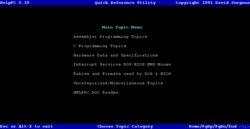Nostalgic HTML Conversion of the HelpPC Shareware Reference
Posted on 2006-07-10 15:00 by Timo Bingmann at Permlink with 5 Comments. Tags: #helppc #fun
Browse the converted HelpPC Reference Library
The HelpPC Shareware Reference is an collection of reference information from 1991 concerning the PC and PS/2. It was created by David Jurgens and includes a hypertext viewing program for DOS. The reference library may be old, but many parts are still applicable to present-day PCs.
During some nostalgic moments I remembered the fun and motivation I received out of this reference during my early programming years. I found out that only a very crude transcription into HTML existed on the web at http://heim.ifi.uio.no/~stanisls/helppc/and decided to create one which is more true to the source.
Main Goal for the new converter was to retain the look and feel of the old DOS hypertext program: the use of CSS including the pseudo-class "hover" allowed me to create a HTML page with remarkable similarity. The special ASCII character are not included in the standard HTML entities, however the can be found in the Unicode character table. The converter uses a carefully picked set of Unicode dingbats and line symbols to replace the undisplayable control characters. Thus the HTML pages contain no images and can be displayed by any browser utilizing Unicode fonts. All current-day browsers (Firefox 1.5, IE 5, Opera 9.0) display these symbols well.
You may browse the converted files and can download an offline version: as a zip archive (1.2 MB) or a tar.bz2 archive (257 kB).
The converter itself is a Perl script which requires the Template Toolkit and the original HelpPC distribution. All output files are valid XHTML 1.0 Strict. To run the converter download the following files from on of the locations:
| Original HelpPC distribution (255 kB) | from Simtel.NET | local copy |
| Converter Perl Script (15 kb) | download | display code |
Extract the zip file and run the Perl script in the path containing the .TXT files. The script will create a subdirectory "html" with 1015 XHTML files. You can modify the nostalgic.css or the embedded text templates to fit your taste.
